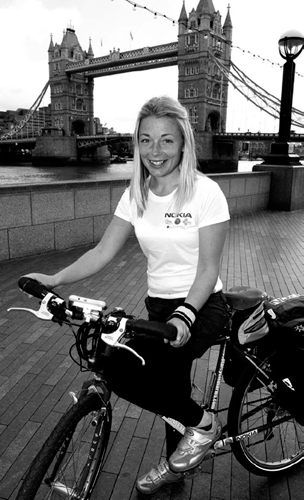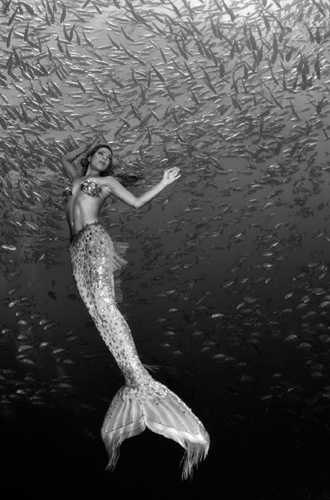The Next Eco-Warriors (32 page)
Read The Next Eco-Warriors Online
Authors: Emily Hunter

Everywhere we went, we spread awareness of the potential of solar energy by meeting with politicians, giving talks, and getting media coverage. It was heartening to be so well received by people in every corner of the globe. Gainesville, Florida, even had a solar cycling week scheduled around our arrival with cycling and solar events taking place all over their university. It was inspiring to meet people in countries so far away from the UK and where we had started, absorbing and incorporating our message. Each and every encounter reminded me of the potential we all have to help build a positive future.
Much of what we were promoting will only be achieved with support from big companies and organizations. I believe that these kinds of organizations will have to be involved with efforts to mitigate climate change. I only hope that their involvement in projects like ours encourages them to become ever more sustainable themselves
.
But in that moment in central China, the irony of cycling to promote solar energy and getting caught in a snowstorm was not lost on me, or my frostbitten toes. Long after night had fallen, we reached a town and saw the lights of a small hotel. Chilled to the bone, we lugged our muddy packs inside the hotel and took a room. With visions of a hot bubble bath dancing in my head, we boiled water in a kettle just as the power went out due to the storm. Leaving us with no heat, hot water, or luck. We were so close to the end, but my spirit was so low that night that I briefly considered just packing it all in and heading home.
The following morning we spent four hours chipping the ice off our bikes and made it to Shanghai at long last. I ventured out to buy shoes while my teammates warmed up, and there I was in a Shanghai market with frostbitten, swollen feet and feeling as blue as my toes, when I saw the one item I knew I needed at that moment to lift my spirits. A pair of red stilettos.
Yes, that's right. I wanted to feel like a woman, and I missed not being covered in sweat and grime from the road. I needed this little bit of normalcy to remind me that this was only a brief moment of misery in what would turn out to be an incredible life experience. I rammed my aching feet into those heels that night in Shanghai and celebrated with Jamie without a second thought about the past week of cycling in snow hell.
Upon arriving home, we were met by a huge crowd of our biggest fans at Stansted, just outside of London. Namely, members of our immediate families, waving banners and holding welcome home helium balloons. We had a great evening catching up, and were fed more than it should have been physically possible. Waking up the next morning for our final pedal to the finish line, we opened the curtains to see a flake of snow fall. For the last time, we donned our thermal gear, layered up, and set out on the last leg back to city hall.
In the end, we made a video of our journey that was aired in the House of Commons. Partly because of the awareness we brought to solar energy, a feed-in tariff program was initiated in early 2010, providing cost-effective means for the solar industry to flourish in the United Kingdom. Our expedition supported the Desertec program, which has begun a solar industry in North Africa and the Middle East. We also raised ten thousand dollars for SolarAid to help build further solar energy projects in the developing world. And while my global trek may have ended, the journey of alternative energy is only beginning.
_________
Susie Wheeldon is currently writing a book about her cycling adventure, any proceeds of which will go to support SolarAid. She plans to continue to save the planet through adventure, with trips in motion for 2012. Meanwhile, the solar industry in the UK is growing after the feed-in tariff program was introduced
.

PHOTO BY SUSIE WHEELDON
 Twenty-nine
Twenty-nine Australia
Australia Mermaid
Mermaid

PHOTO BY CIPTOAJI GUNAWAN
Another world is not only possible, she is on her way. On a quiet day, I can hear her breathing
.
—ARUNDHATI ROY
IT DIDN'T HIT ME UNTIL AFTER THE massacre came to an end.
It was the first moment of calm after the storm; the shock started to set in, and my hands began to shake. We tumbled out of the getaway van, and I stood out on a rocky cliff, looking out to the windswept ocean. My heart sank as I grappled with the understanding that the dolphins I had been swimming with less than an hour ago were being systematically slaughtered. At that very moment, they were probably drowning in their own blood. Emotion overcame me. I was frustrated and helpless. It was the way in which they were being killed, a casual brutality that struck me with a chill far colder than the icy waters of Taiji Bay in which I had just been swimming.
I thought to myself, How could we as a species be capable of acts of such cruelty? How could these fishermen blindly sacrifice their own humanity on the points of their spears?
I started to weep.
My fellow activists crowded around, comforting me. We all took a moment to comprehend the loss. I gazed into the faces of these brave souls, their eyes haunted, swimming in the torment of what they had just witnessed; however, I felt reinvigorated by the knowledge that my friends had put their lives on the line for animals that could not speak for themselves. My faith in humanity might survive after all, but only because of people like these.
I was left wondering how to comprehend the contrasts of the human species. Are we really so polarized between good and evil? Or are we all just doing the best we can with the knowledge we have? And then, is knowledge the key that will end the unnecessary slaughter of life, like what I had experienced in Taiji?
The annual dolphin slaughter carried out at Taiji Bay (otherwise known as the Cove) in southern Japan certainly challenged the way I thought about the world and humanity. These murders have been ongoing for many years, and despite the vigilant efforts of activists such as Ric O'Barry—the original
Flipper
trainer and longtime dolphin activist—the killing remains protected by the Japanese government. Why? So we can touch a dolphin's nose and watch them do tricks for us in marine parks. But in our pursuit to get closer to these wild animals, we are slaughtering them.
I have seen the underwater world change before my very eyes in my short lifetime. It's easy to ignore what we can't see, but there is a beautiful world beyond our own, a world beneath the waves that is critically out of balance because of us. I fear that if it dies, we all die
.
The “lucky” ones caught in Taiji Bay are captured and kept in captivity for the remainders of their lives. For wild dolphins, their newfound cage can lead to severe psychological and mental disorders and, in some cases, suicide. The rest of the dolphins captured, those not pretty enough to entertain us, are hacked into pieces and sold as mercury-poisoned meats. Twenty thousand such dolphins find this fate annually in Japan.
Fighting for cetaceans has been my life's purpose. Not so that I can dictate to another culture and people how they should live their lives, but because I have wanted justice for the oceans for as long as I can remember.
I have always felt connected to the oceans. When I was nine years old, I fashioned my first mermaid tail so that I could experience life under the sea. Despite living near the desert, hours from the ocean, I happily swam for hours in our pool, telling stories of how I had traveled to the bottom of the sea and met all the ocean creatures. As I grew up, my passion turned into a
career as a professional mermaid, a performance artist that swims and looks like a mermaid. I have been featured in films, photo shoots, music videos, and advertising for my work.
I learned how to free dive, diving to the depths of the ocean with only the oxygen in my lungs, and created my own specially designed mermaid monofin tail that gave me the speed, agility, and courage to swim in the ocean. I swam with whales, dolphins, seals, turtles, and even great white sharks. Through these techniques, I gained access to the underwater world in a way most humans never have, as if I was part of this world myself, not just an alien tourist. I witnessed the intelligence of these marine creatures up close and interacted with them as if I were one of them.
After years of work and practice, my dedication to being a mermaid finally gave me the opportunity to swim with humpback whales in the South Pacific. As I swam alongside, the curiosity of a baby whale brought me closer to a cetacean than I had ever been. It was continually looking at me in the eye and playfully swimming around me. I could hear the deep bass notes of its mother singing. The vibrations ripped through me like a blasting speaker, rumbling my ribcage. It was cold, dark and difficult to see, but any fear melted rapidly away when these leviathans glided effortlessly around me, taking care to avoid buffeting me with their massive tails while they looked closer. It felt like my cells had been rearranged by the sound of their song, and I was touched by the realization that despite my kind killing theirs for centuries, these intelligent beings still chose to swim and play with me.
So my connection to the oceans has been nothing short of a lifelong love affair. But traveling to all corners the world with my mermaid performance, I have seen the underwater world change before my very eyes in my short lifetime. It's easy to ignore what we can't see, but there is a beautiful world beyond our own, a world beneath the waves that is critically out of balance because of us. I fear that if it dies, we all die.
